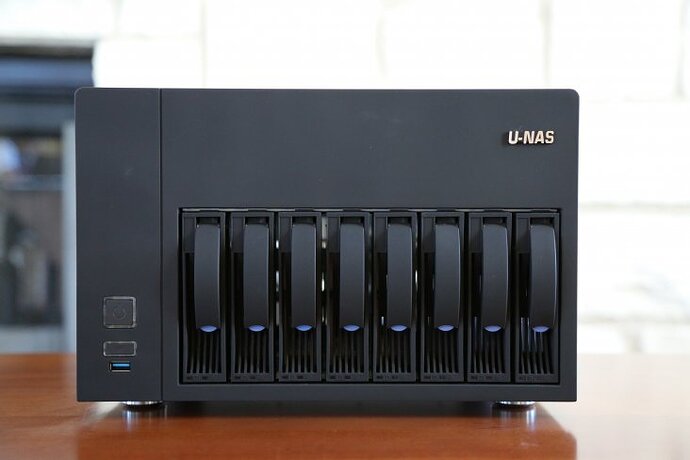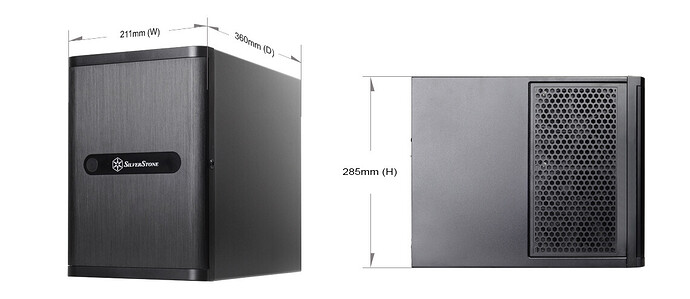Only the “x” or the “pro” versions support ECC. The ones you link are actually called pro due to the xx50 coding. The 5600g, 5700g, etc do not.
ECC support by AMD processors has, I’m afraid, little to do with TrueNAS…
CPUs intended for desktops have long supported ECC, and still do.
APUs intended for laptops or small form factor PCs do NOT support ECC unless they are of the Pro version—Intel-style segmentation creeping in.
CPUs are now chiplets designs, while APUs are a monolithic design. The I/O die of CPUs is somewhat power-hungry compared with the monolithic APU; the above figures show that the difference is about 10 W, which is not negligible.
Simple.
What’s now murkying the waters is that Ryzen 7000+ CPUs now have an iGPU, like the APUs, while some APUs with a disabled iGPU (think “Intel F”) are masquerading within the 5000 CPU stack: These have lower idle power but do not support ECC (e.g. 5600 vs. 5600X).
OK, so be clear, you agree that
- the Ryzen Pro 5650G and the 5650GE both support ECC?
- the X570D4I-2T also supports ECC?
- Thus, a mini-ITX system based on the X570D4I-2T and the Ryzen Pro 5650G or 560GE would allow the use of ECC RAM?
The whole reason I went through finding multiple boards as a better alternative to the one used in the OP system is, among other things, proper ECC RAM support, IPMI, etc. I’d also add a Titanium ATX PSU and better case like the Lian LI Q26 in my household. All of which make the resultant system a lot more expensive than the OP’s or yours.
Rather than focus on whether ECC is or is not allegedly important (and it’s a pretty broad assertion that the TrueNAS community is retreating from a ECC RAM requirement on the basis of one user posting a link to an alternative for the now defunct MiniXL+ iXsystems product), I’d rather focus on the improving compatibility between TrueNAS and AMD processors.
As a community, we really need a bit more competition in the server space to bring lofty Intel profit margins back down to earth and AMD is currently our only real alternative for anything but entry-level NAS that have to make serious compromises (i.e. most of Synology, QNAP, ReadyNAS, and like platforms).
I wouldn’t consider a motherboard / CPU combination for a TrueNAS server if it didn’t include IPMI and ECC RAM support, but the beauty of TrueNAS is that it can be made to run on a wide variety of platforms, including even some QNAP boards. Everyone can make their personal tradeoffs of cost vs. performance vs. reliability, etc.
…particularly when that user notes (perhaps incorrectly) that the product in question does use ECC, and points that out as an advantage over its apparent nearest competition.
One of the interesting aspects of the Asrock Rack board is the Oculink ports. At 4x PCIe 4.0, you have access to 8GB/s raw transfer, which is as fast as PCIe 3.0x8, so you could add a HBA on one Oculink, a NVME riser on the other and still have the hardware slot free. That board could easily drive 20+ SATA drives and still have room for a fast sVDEV array. Nuts!
Unless the guys at 45Guys slipped Lisa Su some cash under the table and got the dies / Zen3 architecture custom made for their rigs, the 5500GT / 5700G CPU’s in the OP HL8 build will NOT run ECC. Again anything is possible in this world, but only if 45drives get custom made CPU’s from AMD for the quoted system. I have doubts they are big enough to do that.
I am sorry Dan, but I don’t feel like digging up all the threads where people come to the old forums and get told to go forth and multiply because they didn’t used pre-approved hardware from IX hardware specs.
Here we are spotlighting a build, supposedly marketed to servers / NAS on the new Truenas ‘discord-style’ forums that does NOT support ECC ram and its only 23 posts down that someone notices this.
You got me all wrong Constantin. If you think I am shilling Intel then thats a mistake. I think competition is awesome. I think its GREAT we are using AMD. Like I said in the thread you linked, AM4 is probably one of the most proven and successful CPU platforms in the past 20 years, perhaps ever.
Yes the worlds servers largely run on Intel. They have earned that right from previous excellence. That said, I think we have to start preparing for the unpleasant fact that Intel is fast approaching (or has already entered) the Enron style “loot the treasury” form of corporate malfeasance / incompetence. Pic related.
This is my opininion of course, but somehow I don’t think Andy Grove would have issued the “no refunds losers!” statement the current leadership did for their failing / rusting CPU’s to customers less than a year into their life.
There is no doubt that right now AMD is better managed, with more creative use of engineering in deploying new products. The fact that the AM4 5800x3d STILL runs neck and neck in gaming benchmarks with i9 300w+ housefire chips just by adding some L3 cache is pretty amazing.
I can’t comment on the Asrock Rack compatibility with the xx50 pro processors. These are OEM Lenovo batched processors; they worked with my b550 but only with the BIOS in QSM mode. I don’t know where on Asrock website they list CPU compatibility. Mayhaps an email to them would be more reassuring? I don’t want you to drop Asrock Rack style cash on a MB and find out the system won’t post.
No worries, you don’t have to. Both the 5650G and the 5650GE are on the official Asrock Rack hardware QVL list for the X570D4I-2T motherboard.
Though, as far as I can tell, the purpose of that board is to run flash arrays, not rust, even if the X570D4I-2T has 4-port SATA compatibility on each of the two Oculink ports.
There is a difference between validated support for ECC (see the pro 5650G) and the non-validated but present support for ECC, as evidenced here.
Buying a non-validated ECC CPU basically means that it’s up to the consumer to make it work whereas the validated solutions allegedly offer some sort of assurance that it will work.
Given the uneven support that Asrock has shown this community over the years, I would be highly doubtful that there is any kind of real handholding, validation or not. They seem to be focused on B2B, not consumer support. It’s one reason I much prefer SM, all things being equal.
This I knew, very interesting article btw. I like how they simulated via reckless overclocks to test whether non-validated ECC on normie hardware actually prevented bit flips. The system DID log these, but it was ambiguous whether they were fixed afterwards. If you are larping as a data center at home with mission critical information on your NAS, doing a AM4 ecc build is totally not what I am recommending here. Spend the cash and get a proper server (Epyc or Xeon) man. Don’t strawman me here guys.
That said, I don’t believe Truenas has been as successful as it has been by exclusively being used by people hosting NOC list type information on their home servers:

My very humble assessment is that non-validated ECC is “good enough” for the vast majority of home server cases (media, photos, personal files) because you also get integrated onboard graphics (Vega) and cheap but proven motherboards (am4) with lots of options for suppliers. If you go Xeon, you need to buy an dedicated graphics card. Or you need to buy a $400+ w680 board to match with i5/i7 cpus just to get ECC support.
The “advice” on reddit is just to get used 10+ year old Xeon poweredge dell servers that still allowed quicksync for everything all in one. This is not wrong. However, in my assessment getting 10 year old tech off ebay is a WAY bigger risk to your data than non-validated AMD am4 stuff like you wrote.
There’s no need; I was there, and I remember–well enough to know that, to put it charitably, you’re exaggerating[1].
No. Here I[2] am mentioning a product that I think would be of interest to the community. One of the reasons I think it would be of interest is that I believed, based on the product information page, it supported ECC. You believe this to be incorrect, and that may be the case–but your conclusion that this indicates a softening of the pro-ECC stance of this community is frankly bizarre.
Point taken. I was trying to have some fun with this (my post was indeed slighly polemical), but this thread got lawyered up fast with footnotes and citations. The OP is a cool build, and I was very thankful for sharing it, indeed that was my first sentence here. I still think its a great build. My humor is not taken well here. I will politely refrain from using it. I will repeat with utmost sincerity that the two optional CPUs on the build page will not give you ECC support unless they got custom made CPU’s from AMD directly.
The chassis obviously “supports ECC” if used with a properly ECC-enabled server motherboard. Even the pre-configured system would, somewhat, support ECC UDIMM as the included desktop motherboard allows, that is when using a suitable CPU (or rather a Pro GE APU) and without server-grade validation or certification.
In my opinion it is way too expensive for what it provides (8 user-acessible bays), but it is of some interest by virtue of being available hardware.
There are always compromises. If you want “compact” (as many people do), price is going to be one of them (cooling and hardware availability will be two more). If you want an 8-bay NAS as compact as possible, I think UGREEN is hard to beat–but the proprietary motherboard is a definite drawback (and it doesn’t have ECC RAM). I think this unit is a strong competitor, and the option to DIY it means you can use any (Mini-ITX) motherboard you want.
Dimensions in mm:
| HL8 | UGREEN | |
|---|---|---|
| L | 303 | 360 |
| W | 201 | 258 |
| H | 199 | 200 |
Edit: source for the UGREEN dimensions: Reddit - Dive into anything
So my eyeball assessment in the OP was wrong; the HL8 is smaller in every dimension than the UGREEN DXP8800+ (though very marginally so in height). That, IMO, makes it an even stronger competitor: smaller, cheaper (using the price for the complete system 45Drives sells vs. MSRP for the UGREEN), support for additional SATA SSDs, and the motherboard @Constantin suggests gives the 10 GbE the bundled one is lacking (and it’s Intel rather than the Aquantia in the UGREEN unit). ECC support with the right CPU. IPMI. x16 PCIe vs. x4 for the UGREEN. Damn, this is getting tempting, but I have no need for such a thing right now.
Can you get eight bays for less money? Sure. Can you do it as small as this? I’d love to see it–and I mean that sincerely.
I missed the old UNAS 800C.
Or whatever.
Apparently it’s back ![]()
8 hot swap 3.5” + 2.5” + mATX and 2 PCIe.
Not sure if that’s as compact as the HL8 (my guess would be no), but support for µATX mobos is a definite advantage.
Yes. I’ve been thinking my next compact nas is probably going to be mATX.
IIRC the issue with the UNAS is very little vertical height for cooling above the CPU. Although I do seem to recall people getting high TDP CPU’s in them.
Regarding the mini. I think for Raidz, 5 bays is a sweet spot.
My Node 304 with 6 sata and the X10SDV is still great, but the board is getting long in the tooth, and it’s hit 75% full, I think I’ll be increasing its disk size for more space… but time to think about a replacement.
I had not guessed you were THAT focussed on small size…
For full disclosure, my own focus is on low noise while cooling drives (nothing that eight spinners cannot be “silent” anyway), then I would appreciate having hardware options (the choice of mini-ITX server boards is plentiful enough for me; “SFX only”, excuding SFX-L is an annoyance, but having one or two Flex-ATX PSUs to choose from is a red flag). Size, for me, comes absolutely rock bottom—and I’m easy enough to please here, with a Node 304 being certainly small enough for six drives. YMMV.
I did a little research and here’s what I came up with alongside the above mentioned cases, in order of decreasing volume (Cooler Master N400 ATX tower, Node 804, 40 litres each; Node 304, 19.6 litres):
For reference only, since the case is milled off pure unobtainium (and goes beyond the requirement for 8 drives):
- Lian-Li PC-Q26 10 bays, mini-ITX MB, ATX PSU: 32.4 litres (200x395x410 mm)
good cooling, amazingly quiet and compact for what it holds, fair choice for components… one quality short of perfection—availability

- Inter-Tech NAS-8 ATX MB(!), SFX(-L?) PSU: 25.6 litres (240x295x362 mm) 210€
I’m unsure how drive cooling works with a drive cage surrounded by a mesh front, but kudos for fitting a full ATX motherboard and seven half-height slots in a 8-bay NAS
- Silverstone DS-380 mini-ITX MB, SFX PSU (strict!): 21.7 litres (211x285x360 mm)
drive cooker and absolute pain to work with the innards: a case I thoroughly HATE, and advise AGAINST, but it certainly looks small
-
UGREEN NASync DXP8800 Plus 18.6 litres (360x258x200 mm), $1500 full system
as built, Thunderbolt and 10 GbE, but no ECC: not a prime candidate for TrueNAS -
Jonsbo N3 mini-ITX MB, SFX PSU (strict!) 18.2 litres (233x262x298 mm), 150€
on pictures, this looks like the best cooling design in the N line and easy to work with; I’d take an A2SDI build in there over the above UGREEN
-
U-NAS 810A micro-ATX, MB, FlexATX PSU: 17.1 litres (315x275x197), $220
amazingly, @Stux’ find comes up smaller than the N3, with many possibilities for micro-ATX motherboards BUT not so many for the FlexATX PSU -
45Drives HL8, mini-ITX MB, FlexATX PSU: 12.1 litres (303x201x199 mm), $600 case only(!)
it sure is small, very small, but I have to question what attempts to pass for a back exhaust… (not to mention the price)
I’m not, especially–but a lot of people are. Though right now, when I’m away from home and in a rental without a detached workshop to put my server rack, it’s more of an issue for me than it otherwise would be.
Options are limited, but not that limited:
https://www.fspgroupusa.com/ecommerce/ipc-psu/flex.html
Do I need to keep going?
Not unless you want to, but searching for 500+ W FlexATX PSUs with Gold rating or better in my favourite price engine litterally returned a grand total of two hits. It might be that the other models are not currently available in and around the German market, or (possibly more likely) are not fully referenced and classified by the engine, making them unsearcheable, but having to spend time to search extensively for products which may or may not exist is not a good start…
On closer look, the above Apevia is not rated and the Platinum-rated Enhance is out of stock. The propspects may not be absolutely as bad as I first tought, but it still seems easier to find a mini-ITX server motherboard than a FlexATX PSU—and @Stux has a meme for that…
Thankfully I’m not in need of building yet another NAS, merely still curious about hardware that I will have to resist the urge to hoard “just in case”…





